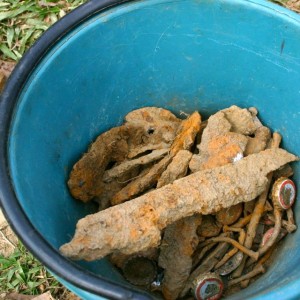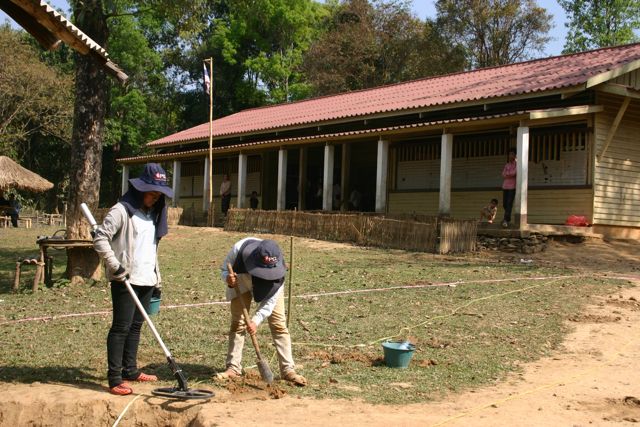Project Phongsali 2011: When clearing a schoolyard we’d rather be thorough than efficient.
Day Twenty-Seven
Today we’re clearing the schoolyard in Kiew Ka Cham village. It’s slow, tedious work since searching for UXO in a heavily trafficked area, such as a school or marketplace, involves excavating a substantial quantity of non-lethal contamination: nails, washers, bolts, bottle tops and fragments of exploded bomb casings.
As the deminers sweep the area under foot their detectors incessantly sound off, indicating metal objects hidden in the soil but, thus far, none of the signals have led to ordnance.

When we search inhabited areas we find many non-lethal objects. Every item has to be excavated and inspected before we can affirm that the land is clear of UXO.
Still, the deminers must inspect every object before they can affirm that the land is safe. If, wishing to minimize the number of “false alarms,” they adjust their detectors to be less sensitive; they’ll increase the likelihood of missing a dangerous object.
Most of the bomb fragments that we’re finding are finger size or smaller but a few weigh a pound or more. Its not surprising that so much frag is turning up since the countryside around the school is pockmarked by old bomb craters. (Our bomb data map shows that during the war this stretch of roadway, and the villages along it, were repeatedly targeted).
It’s a Sunday so no students are present but the head teacher stopped by for a chat. He told me that in all the years he has worked at the school, students have never found ordnance on the playground. But, he then pointed to nearby fields where farmers have found cluster bomblets.
NOTE: It’s dawned on me that in many of my posts I use phrases such as “clearance team,” and “area clearance,” without actually explaining what activities those words connote.
We “clear” land by systematically searching the area with the intention of locating and destroying all unexploded ordnance that is present within a predefined depth. The search usually involves highly specialized equipment but also requires deminers to make observations and, ultimately, to unearth objects by hand.
For instance, we might search an area with equipment set to a level of sensitivity that can detect metal objects equal in mass to half a BLU 26 cluster bomblet, at a depth of 25cm. If we don’t find any ordnance within those parameters, we can certify that the land has been “cleared”.
UXO clearance takes time. When performed correctly every square inch of land must be explored; failing to properly search an area no bigger than a ping pong ball could result in our missing an unexploded device that can occasion a kill radius greater than 15 feet.
Standards are subjective and must be based on how the cleared land will be used in the future. Land “cleared” for a shallow endeavor like rice farming might only be searched to the depth of a farmer’s plow; that land might continue to be a hazardous place to dig a well or to set bridge footings, endeavors that rely on much deeper searching.

